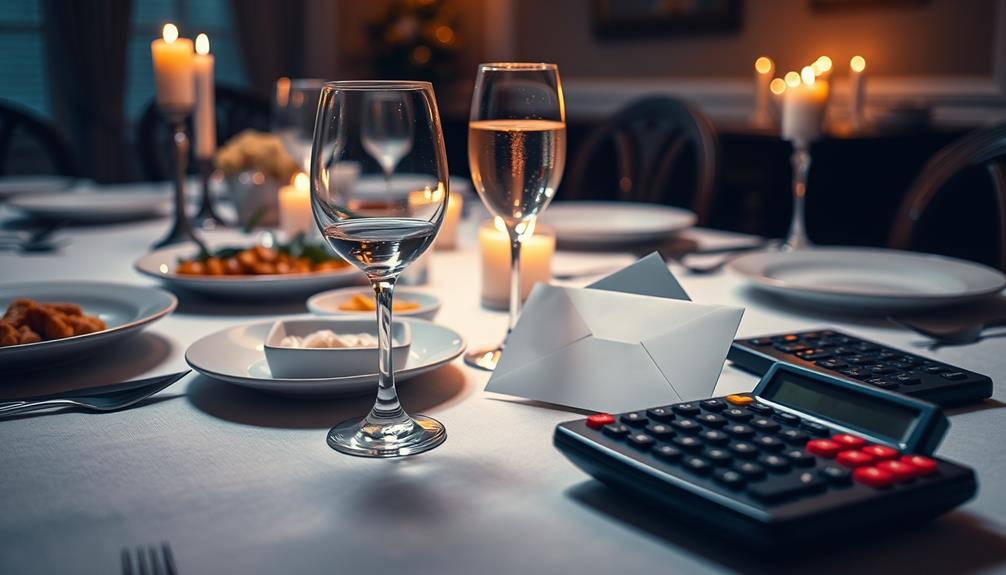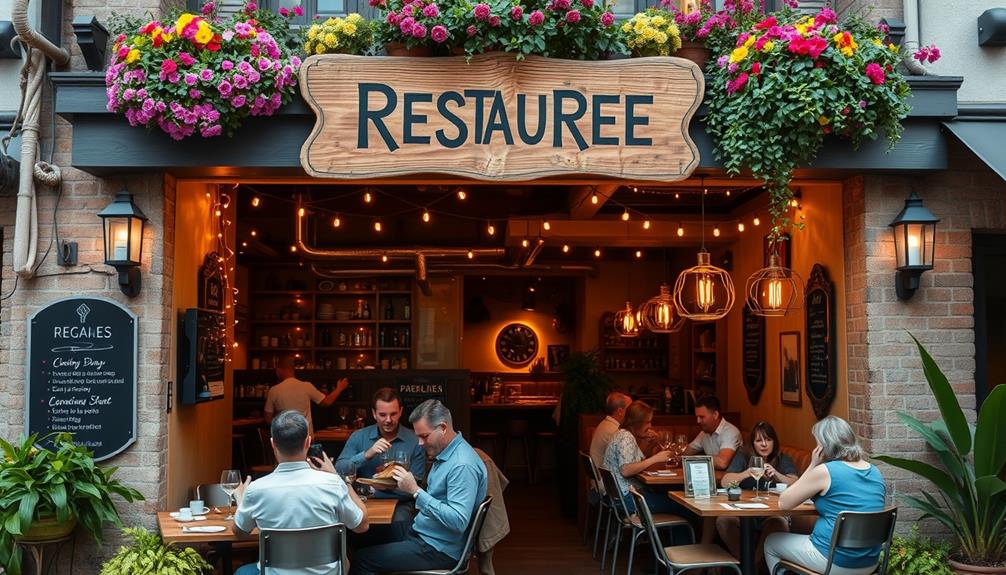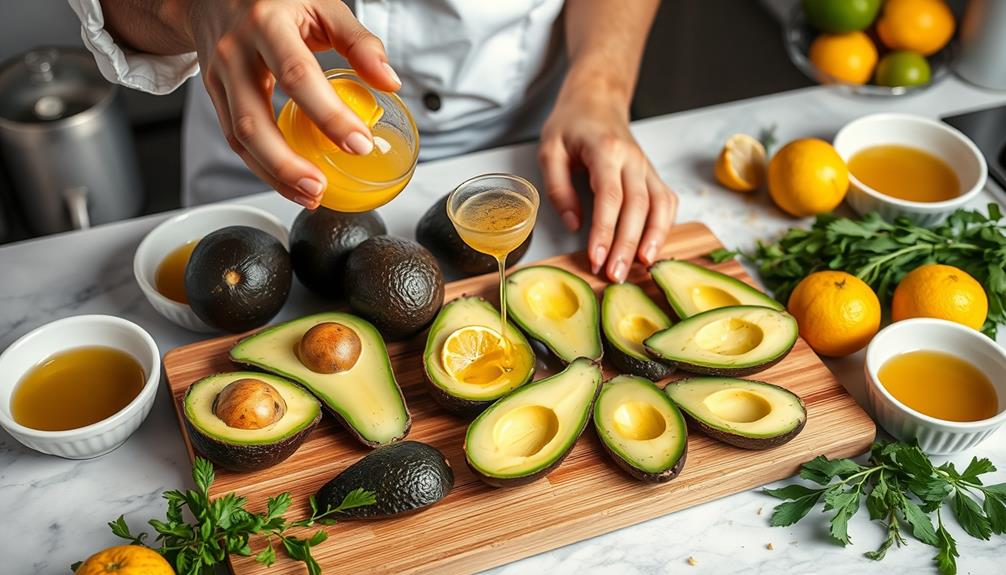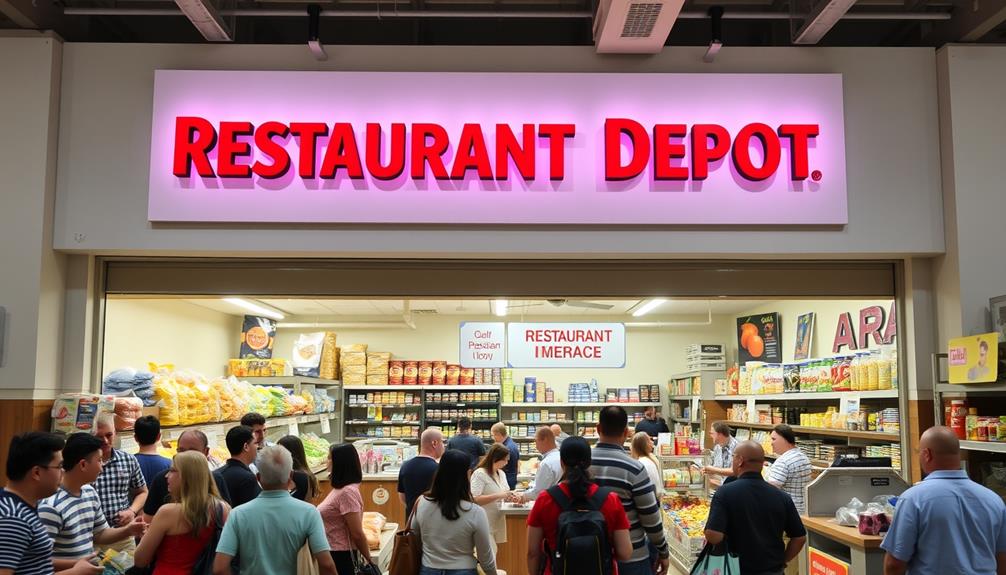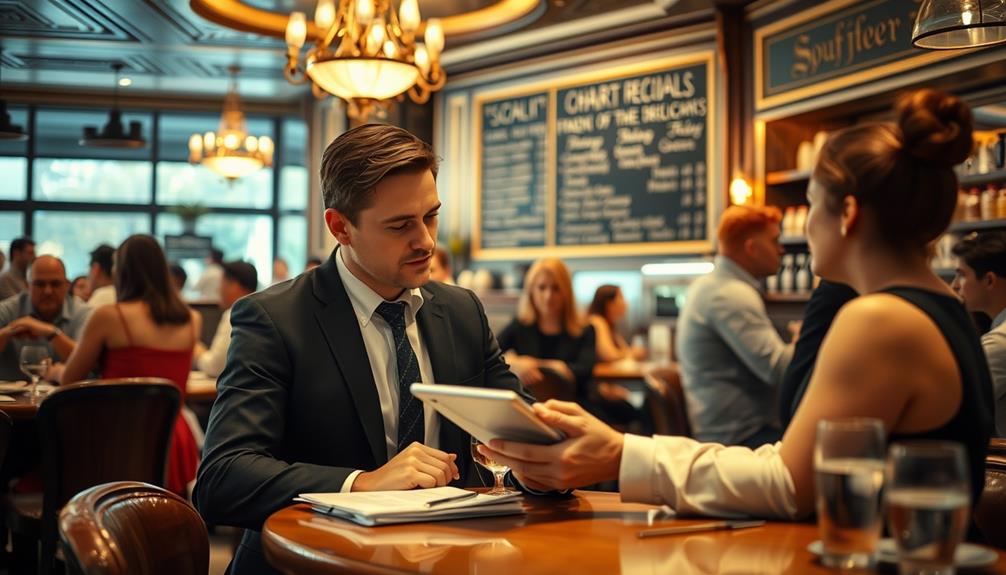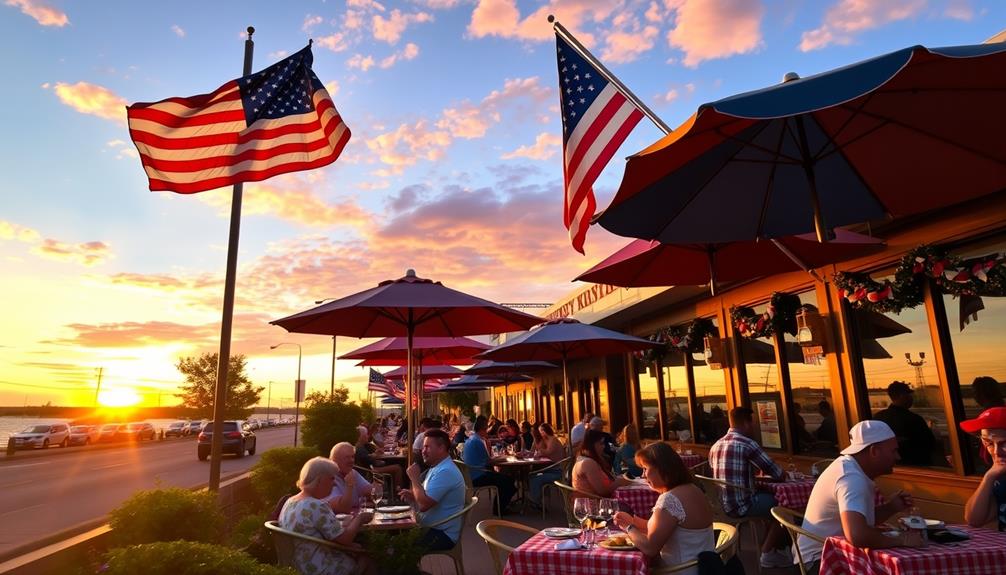When you're dining out, it's standard to tip between 15% and 20% of the pre-tax bill. Many people find that 18% is a good baseline. If you get exceptional service, you might want to tip 20% to 25% to really show your appreciation. For buffets, aim for a minimum of 10%, adjusting based on the service received. If you're unsure, checking if an automatic gratuity is added is always a smart move. Tipping is important, as it directly affects your server's income. Want to find out more about different dining scenarios and tips?
Key Takeaways
- Standard tipping at sit-down restaurants is 15-20% of the pre-tax bill, with 18% as a common baseline.
- For excellent service, consider tipping 20-25% to reflect the quality of service received.
- Buffet-style restaurants generally recommend a tip of 10-15%, adjustable based on the level of service.
- Tipping for takeout is becoming more common; aim for $1-5 for small orders or 10-15% for larger ones.
- Delivery driver tips typically range from 10-20% of the total meal price, with a minimum of $5 for simple deliveries.
General Tipping Guidelines
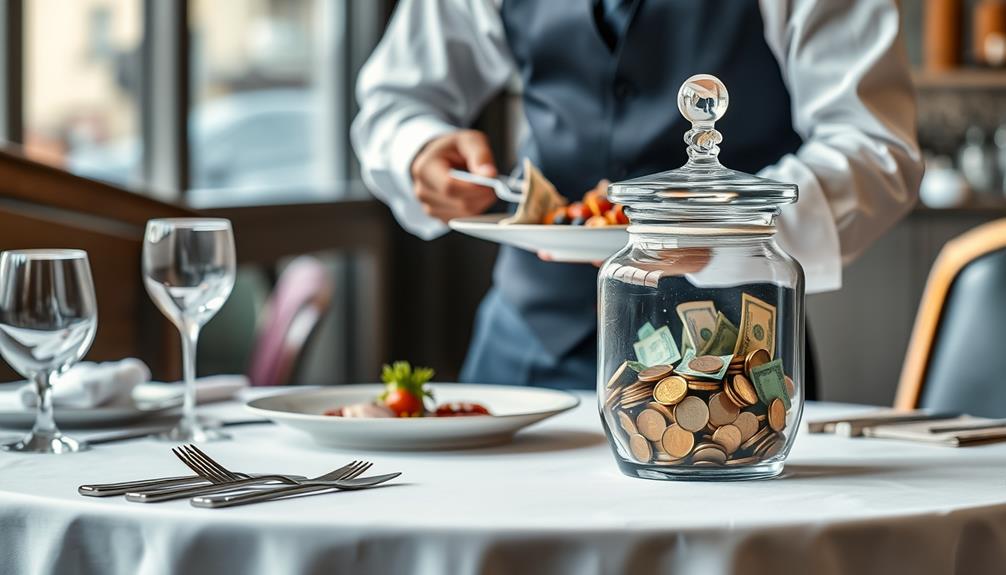
When dining at a sit-down restaurant, you should generally tip between 15% to 20% of your pre-tax bill, with 18% being a good starting point. This percentage of the bill reflects the standard expectations for service quality.
It's important to remember that in many vibrant culinary scenes, such as those in best restaurants with live music, the atmosphere can enhance your overall dining experience and may influence your tipping decision.
If you experience exceptional service, feel free to increase your tip amount to between 20% to 25%. It's a great way to show appreciation for going above and beyond.
In cases where service is poor, you should still consider leaving a small tip as a courtesy. However, it's wise to address any service issues with management, as they might appreciate the feedback and work to improve.
Many diners round up their tips to the nearest dollar, which is quite common in the U.S. and Canada.
Tipping at Sit-Down Restaurants
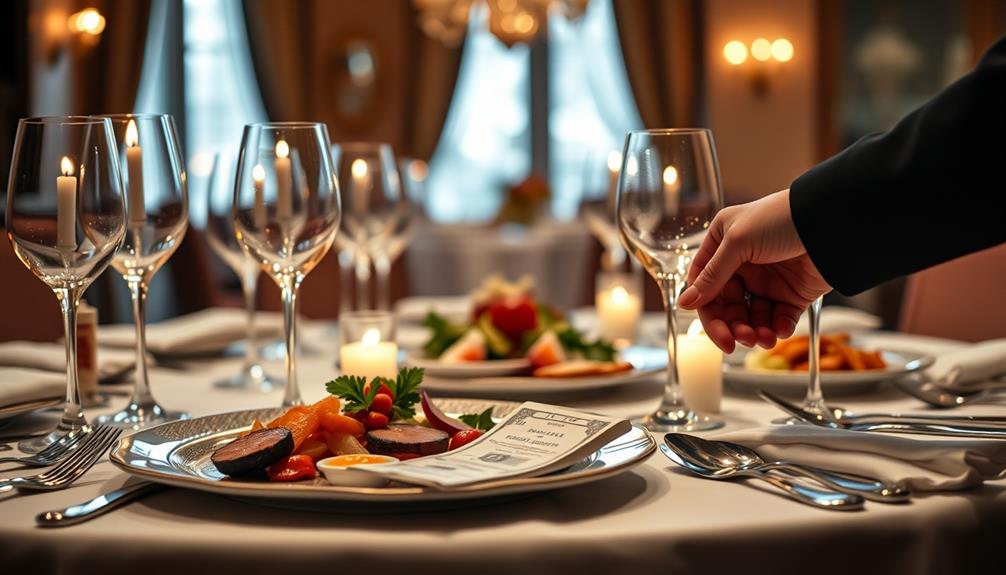
Tipping at sit-down restaurants is an important part of the dining experience, as it directly impacts your server's income. To tip appropriately, aim for the standard tipping range of 15-20% of your pre-tax bill, with 18% being a commonly accepted baseline.
If you receive excellent service, consider increasing your tip to 20-25% to reflect the quality of your dining experience. Additionally, it's helpful to remember that just as with choosing the right cold medication for effective relief, the right tip can guarantee a positive interaction between you and your server importance of selecting the right cold medication.
Before calculating your tip, check the bill for any automatic gratuity, especially for larger parties, which typically ranges from 18-20%.
If you're dining at a buffet-style restaurant, a minimum tip of 10% is recommended, but you may want to increase this amount if your server provides particularly attentive service.
Fast-Food and Takeout Tips
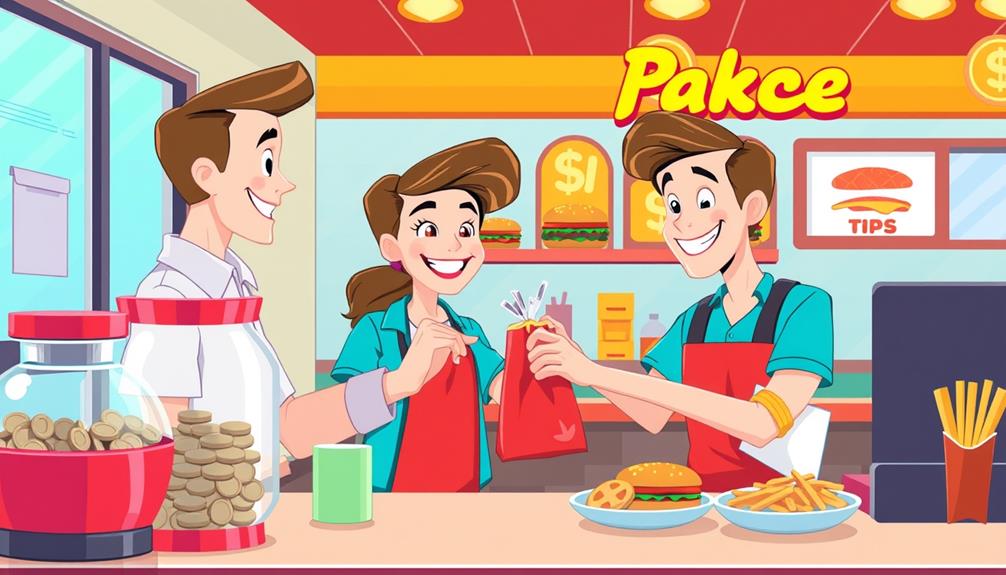
When it comes to fast-food and takeout, tipping isn't strictly required, but it can show appreciation for good service.
Understanding the value of service can enhance your dining experience, similar to how caregivers assess financial considerations for elderly care.
If you receive table service or your order is particularly large or complex, consider leaving a small tip—usually a dollar or a percentage of the total bill.
Keep in mind that digital prompts for tipping are becoming more common, so it's worth thinking about how much effort went into your meal.
Tipping at Fast-Food
Maneuvering the tipping landscape at fast-food restaurants can feel a bit tricky. Unlike traditional dining experiences, tipping at fast-food is generally seen as optional. You're usually at the counter, placing your order, which doesn't typically warrant gratuity unless there's table service involved.
That said, if you encounter exceptional service or have a particularly large order, tipping one or two dollars can go a long way in showing appreciation. It's also worth noting that understanding the nuances of tipping can enhance your overall dining experience, as it reflects your appreciation for service, similar to how a budget helps manage finances common financial terms.
Many customers feel uncertain about tipping at fast-food places. According to an etiquette expert, only about 20% of Americans consistently tip at coffee shops, and even fewer do so at fast-food establishments.
If you find yourself confronted with pre-entered tip screens, remember that you don't have to feel pressured to tip. You can simply select "no tip" if you prefer.
While tipping isn't obligatory for takeout orders, leaving a few dollars (around 10-15% of the total) is becoming more common to acknowledge the effort of preparing your food.
Takeout Service Considerations
Maneuvering takeout service can be just as nuanced as tipping at fast-food restaurants.
While tipping isn't mandatory, it's becoming common to leave a little something to acknowledge the effort involved in preparing your meal. In some cases, similar to how mammography aims to detect breast cancer early, recognizing the hard work of restaurant staff can contribute to a positive dining experience.
Here are some guidelines to contemplate:
- For small orders, tip at least $1-5.
- For larger or complex orders, aim for 10-15% of the total.
- If your order is particularly labor-intensive, consider tipping around $20.
- Always check if delivery fees are included in your overall cost before you decide on a tip.
Digital Prompt Impacts
Tipping culture is evolving, especially with the rise of digital prompts at fast-food and takeout joints. You might find yourself unsure about how much to tip when a screen suggests options. While only about 11% of U.S. adults consistently tip for takeout, these prompts can influence your decision, even if some may annoy you.
Here's a quick guide to contemplate when tipping in these situations:
| Situation | Suggested Tip |
|---|---|
| Basic Takeout | No tip or $1-$2 |
| Complicated Order | $2-$5 |
| Exceptional Service | $5 or more |
| Cash Payments | Always tip in cash |
A good rule of thumb is that while tipping isn't obligatory, acknowledging great service with a small token can go a long way. The service industry thrives on appreciation, and your gesture—no matter how small—can uplift someone's day. Remember, as cashless transactions grow, so does the expectation to tip. It's worth contemplating how you can contribute positively to the service culture.
Buffet Restaurant Tipping
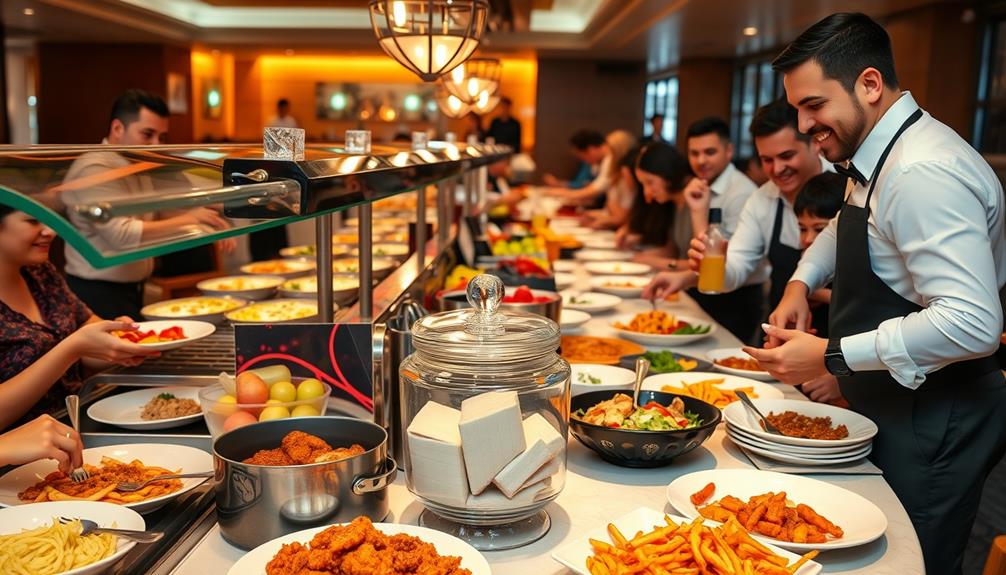
Dining at a buffet can be a delightful experience, but it also raises questions about gratuity. Since buffet dining often involves self-service, you might wonder how much to tip your server. Generally, a standard tip is around 10-15% of your total bill, which reflects the level of service you receive.
It's important to remember that tips contribute to the staff's income, especially in establishments where wages may be lower. Here are some guidelines to help you decide:
- Standard Service: Tip between 10-15% if the service meets your expectations.
- Exceptional Service: For outstanding assistance, consider tipping 15-20% to acknowledge the staff's hard work.
- Service Charge: Check your bill; some buffets include a service charge. If they do, adjust your tip accordingly.
- Minimal Gratitude: If you prefer not to tip, a small token ($1-5) is still appreciated for any assistance you receive.
For more insights on expressing gratitude, consider exploring heartfelt expressions of love.
Delivery Service Gratuities
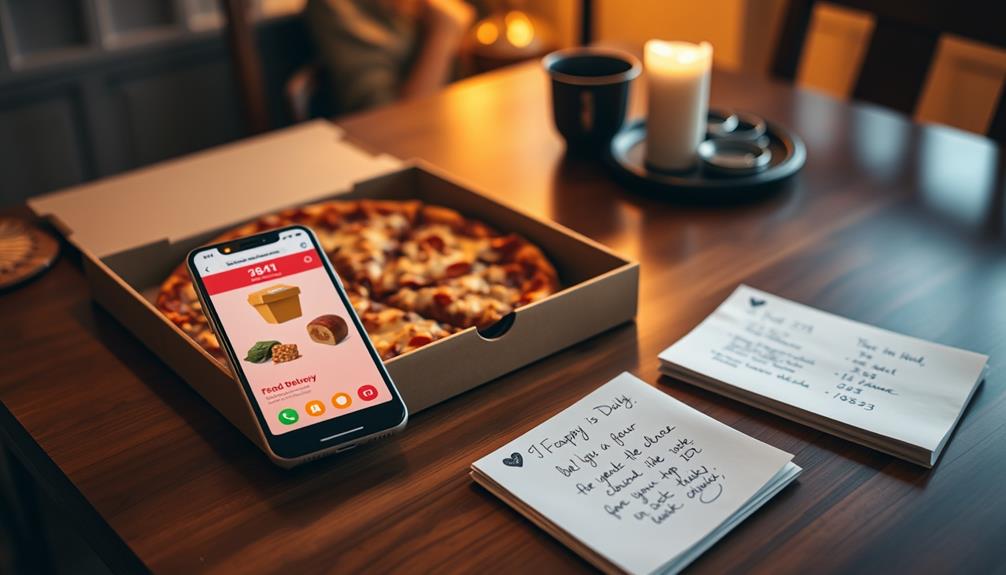
When your favorite meal arrives at your doorstep, it's essential to contemplate how much to tip the delivery driver. Delivery service gratuities generally range from 10-20% of your total meal price, and best ways to earn some extra cash can help you navigate tipping decisions.
For simpler deliveries, a minimum of $5 is recommended. If your order is heavy or complex, consider tipping closer to 20% or even $10-$20 to reflect the effort the driver put in.
Don't forget that if the delivery involves challenges, like bad weather or long distances, you might want to add an extra 3-5% to your tip.
It's important to remember that any delivery fees included in your bill usually don't go to the driver, so be sure to factor that in when deciding how much to leave. Tipping is especially vital for drivers since they often rely on tips to supplement their lower base wages.
Ultimately, when you leave a tip, you're acknowledging the hard work of these tipped workers who guarantee your meal arrives safely and on time. A little generosity can go a long way in showing your appreciation for their service.
Tipping for Bar Services
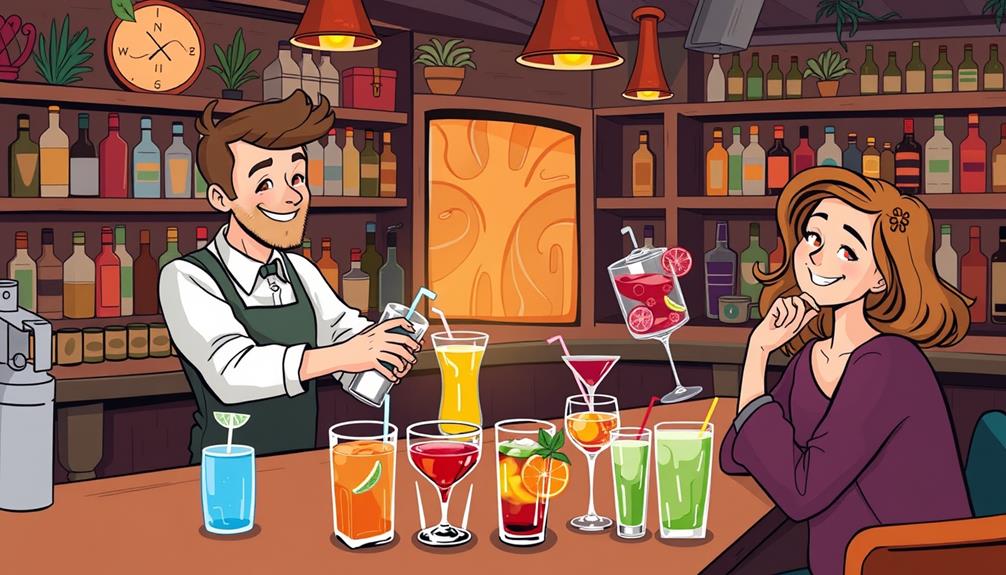
After enjoying a meal delivered to your home, the next social setting that often involves gratuities is the bar.
Tipping at the bar can vary based on what you order, much like the enchanting details of a recent Billy Gilmans secret wedding that captivated many.
Here's a quick guide to help you navigate gratuities:
- Simple Drinks: For beer or basic beverages, tip about $1 to $2 per drink. This is a standard practice that acknowledges the bartender's service.
- Cocktails: If you're ordering cocktails or more complex drinks, consider tipping $2 to $3 per drink to show appreciation for the bartender's skill.
- Multiple Drinks: When ordering several drinks, start with a higher tip (around $5) for the first drink, then $1 for each additional drink.
- Open Bar Events: In these situations, tipping at least $1 per drink is suggested to acknowledge the bartender's efforts.
If you receive exceptional service or order an intricate drink, feel free to tip beyond the standard rates.
This not only shows appreciation but can also make a positive impression for your next visit.
Tipping at Coffee Shops
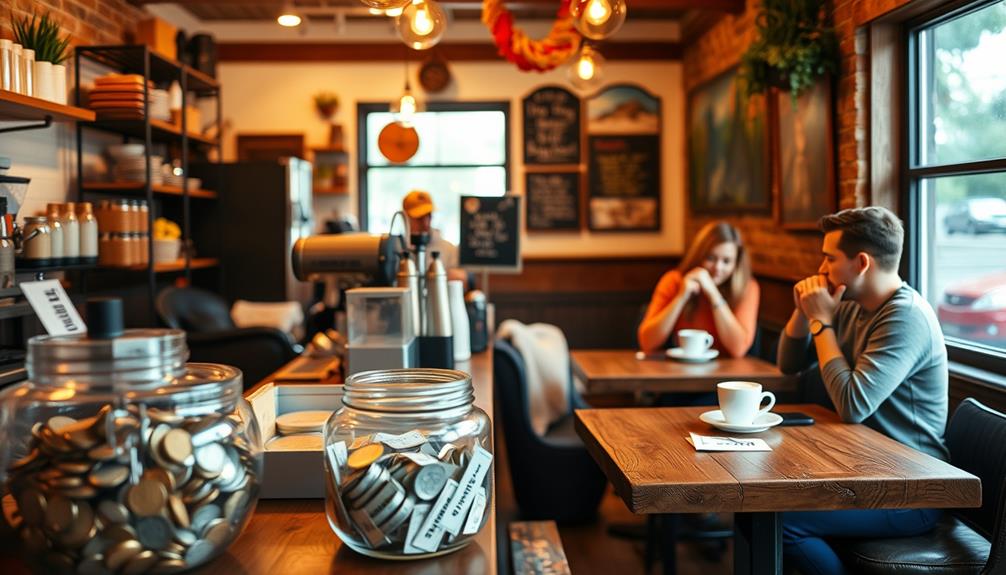
While tipping at coffee shops isn't mandatory, showing appreciation for good service can enhance your experience and build a positive connection with the staff. When you visit your local coffee shop, consider leaving a tip of around $1-2 for exceptional service or customized drinks.
This small gesture can go a long way in acknowledging the effort baristas put into crafting your favorite beverage, especially when you consider the unique brewing methods they may use, such as a French press coffee. For more complex orders or outstanding service, you might think about tipping between 10-20% of your total bill.
Many coffee shops have tip jars, where leaving some spare change demonstrates your gratitude for the barista's hard work. If you're a regular, you may find that building rapport with the staff leads to even better service and possibly higher tips for quality work.
While tipping at coffee shops is less formal than at restaurants, it's still appreciated. It fosters a friendly atmosphere and encourages baristas to continue providing good service.
Personal and Beauty Service Tips

When it comes to personal and beauty services, tipping between 15-20% is standard to show appreciation for the provider's skill.
Quality assurance is essential in ensuring you receive exceptional service, as it reflects the provider's commitment to maintaining high standards best practices in software quality assurance.
The quality of service you receive can influence how much you decide to tip, so consider that when determining your amount.
If you're celebrating a special occasion, don't hesitate to tip a bit more for exceptional service.
Standard Tipping Percentage
In the world of personal and beauty services, tipping is an important way to show appreciation for quality work. The standard tipping percentage typically ranges from 15% to 20% of the total service cost.
Here's a quick breakdown of what to take into account:
- Hair Stylists and Barbers: Always tip between 15-20%, especially for complex styles or exceptional service.
- Spa Treatments: For massages and facials, a tip of 15-20% acknowledges the expertise and effort of your service provider.
- Nail Technicians: Following the same guideline, you should also feel free to tip 15-20%, with higher amounts for intricate designs.
- Tattoo Artists: They generally expect a gratuity of 15-20%, unless the service was unsatisfactory. If that's the case, it's better to discuss it with management rather than withholding a tip.
Service Quality Impact
The quality of service you receive in personal and beauty settings greatly impacts how much you should tip. Just like at a sit-down meal, where great service deserves a generous reward, personal and beauty services follow a similar guideline.
Typically, tipping for these services ranges from 15% to 20%. If you receive exceptional service or a complex treatment, consider tipping on the higher end of that spectrum.
For hair stylists and barbers, a standard tip of 15-20% is expected, but don't hesitate to increase this if they nail an intricate hairstyle.
Spa services, like massages or facials, also warrant a similar tip range—unless the treatment is part of a medical service, where tipping may not be necessary.
Nail technicians usually fall within the same tipping bracket, and the quality of service can sway your final decision.
Tattoo artists also generally expect tips between 15-20%, but if they spend extra time on a detailed piece, a larger tip shows your appreciation.
Always remember, great service deserves recognition, and your tip reflects the effort and skill invested in your experience.
Special Occasion Considerations
Celebrating a special occasion often calls for a higher tipping standard, especially in personal and beauty services. When you're marking milestones like weddings or anniversaries, it's a good idea to show your appreciation for the exceptional service you receive.
Here are some guidelines to take into account:
- Restaurants: For special events, tip between 20-25% to reflect the outstanding service typically provided during these memorable occasions.
- Large Groups: If dining with a big party, check your bill first; many restaurants automatically add an 18-20% gratuity. Don't forget to factor this in before adding more.
- Fine Dining: At upscale establishments, tipping a minimum of 20% is customary, especially for the meticulous attention to detail you receive.
- Beauty Services: For hair or spa treatments, aim to tip 15-20%, with higher percentages for special services or when your technician goes above and beyond.
Traveling and Tipping Etiquette
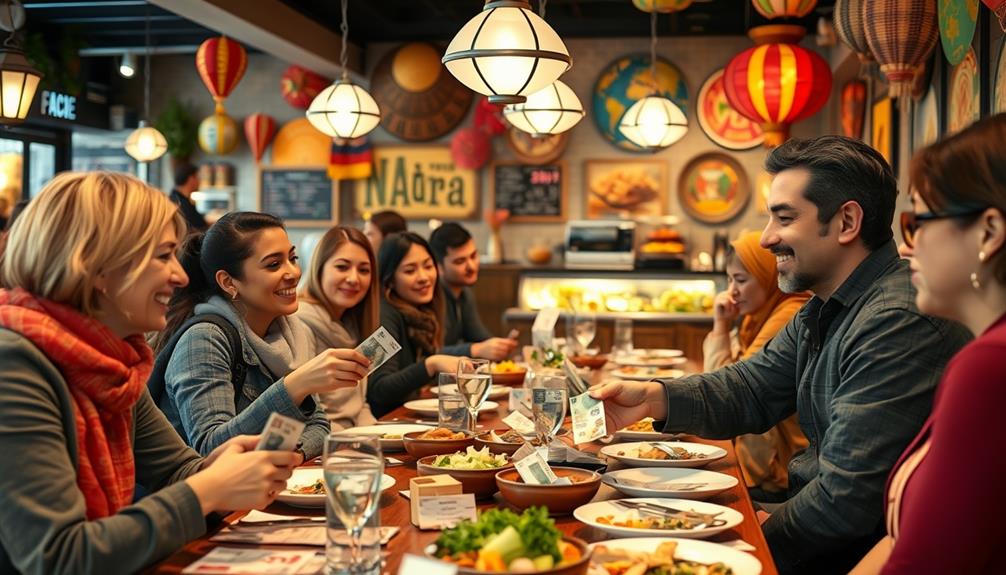
Traveling often brings unique tipping customs that can vary considerably from one destination to another.
When you stay at a hotel, it's customary to tip housekeepers between $2 and $5 per day. Since staff may change, it's a good idea to leave a tip daily.
If you use shuttle services, consider tipping $1 to $2 per bag for luggage handling.
For bellhops, start with $2 for the first bag and add $1 to $2 for each additional bag they assist with.
If you use valet services, tipping typically ranges from $3 to $5, but you might want to give $5 to $10 for special requests, like retrieving your car quickly.
In tourist areas, always check if gratuity is included in your bill, especially for group services, to avoid double tipping.
Also, remember that tipping isn't limited to food and drink; you might want to tip at salons, as well, where the customs can vary.
Calculating and Budgeting Tips
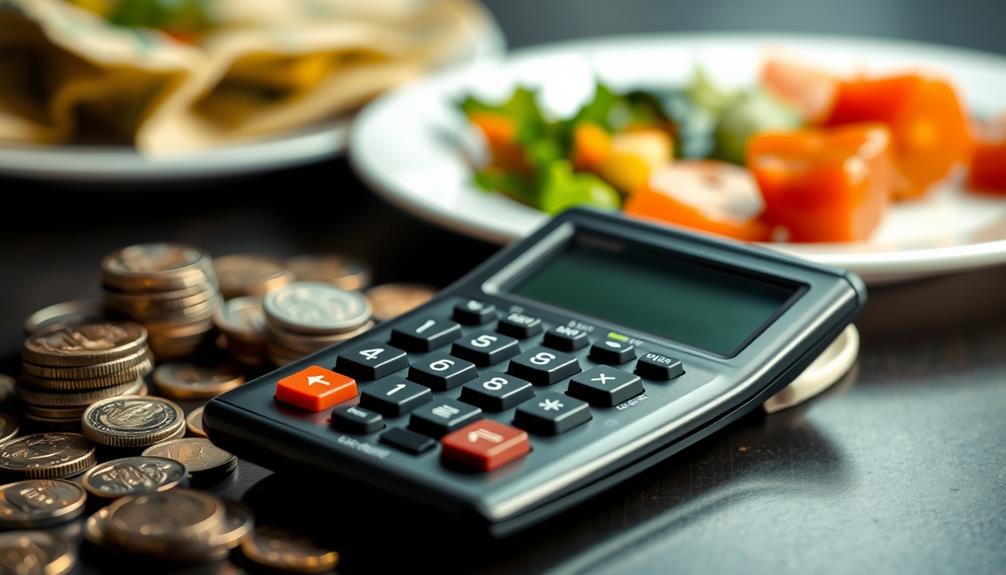
When you're figuring out how much to tip, start by determining the percentage based on the service you received.
Use tools like mobile calculators or budgeting apps to make those calculations quick and easy.
Plus, setting aside a monthly budget for tips can help you enjoy dining out without the financial stress.
Determine Tip Percentage
Calculating the right tip at a restaurant is vital for showing appreciation for good service. The standard tipping percentage ranges from 15-20%, with 18% being a common baseline for full-service establishments. It is important to be aware of the tipping policies at restaurants, as some may automatically include a gratuity charge for larger parties. In cases where gratuity is automatically included, it is still customary to leave an additional tip for exceptional service. Understanding and following these guidelines not only shows gratitude for the staff’s hard work, but also helps to support a fair and respectful working environment in the service industry.
To guarantee you're tipping appropriately, follow these steps to calculate a tip:
- Assess the Service: Determine if the service was good, average, or poor. Good service typically deserves a tip between 18-20%.
- Calculate a Tip: To figure a 20% tip, round your total bill to the nearest dollar, double that amount, and shift the decimal left. For example, on a $43 bill, the tip would be $8.60.
- Budget for Tips: Set aside a specific amount or percentage of your meal budget for tips. This will help alleviate financial stress when dining out.
- Check for Automatic Gratuity: If you're dining with a large group, check your bill for automatic gratuity. It's usually around 18-20%, which means you mightn't need to tip extra.
Use Calculation Tools
Tipping can feel intimidating, but using calculation tools can simplify the process. You can easily determine how much to tip by using your phone's calculator. For decent service, aim for 15%, and for exceptional service, go for 20%.
To quickly calculate a 20% tip, round your total bill to the nearest dollar, double that amount, and then move the decimal left to find your tip value. For a 15% tip, divide the rounded total by 2 to get half, add that to the rounded total, and again move the decimal left for the final tip.
When using a credit card, remember to base your tip on the pre-tax amount of the bill. This guarantees that your server receives a fair gratuity reflecting their service quality.
Many find it helpful to set aside a specific amount each month to manage tipping expenses effectively. By using these calculation tools, you can confidently decide how much to tip without any added stress, guaranteeing you appreciate the service while staying within your budget.
Set Budget for Tips
Setting a budget for tips can make dining out more enjoyable and stress-free. By planning ahead, you can manage your overall dining expenses without feeling guilty about tipping.
Keep in mind that tips are expected, usually ranging from 15-20% for good service. Here's how to set your budget effectively:
- Determine Your Dining Frequency: Decide how often you plan to eat out each month and factor in an average cost per meal.
- Calculate Your Tip: Round your total bill to the nearest dollar, then calculate 15-20% of that amount for your tip.
- Use a Percentage Calculator: Utilize a percentage calculator on your phone for quick, accurate calculations, making it easier to stay within your budget.
- Set Aside Funds: Allocate a specific amount for tips in your monthly budget to avoid any financial stress during outings.
Regularly reviewing your tipping habits can enhance your financial awareness and guarantee that you're tipping appropriately based on service quality.
Frequently Asked Questions
Is a 15% Tip Good at a Restaurant?
A 15% tip's often seen as acceptable, but it might not fully express your appreciation for good service. If you enjoyed your meal and service, consider tipping more to reflect that satisfaction.
What Is an Acceptable Tip?
Think of tipping like watering a plant; a little care goes a long way. An acceptable tip usually ranges from 15-20%, with 18% being the sweet spot for good service that keeps your dining experience flourishing.
How Do You Tip 20% at a Restaurant?
To tip 20% at a restaurant, take your total bill, move the decimal left one place, then double that amount. If that's tricky, round your bill and divide by five to find your tip.
How Much Should You Tip on a Restaurant Bill?
So, you're staring at that $500 bill, feeling generous, huh? If service was decent, you'd tip $75. For great service, bump it to $100. Outstanding? Go for $125. Your choice, really!
Conclusion
In the end, tipping isn't just about money; it's a reflection of your appreciation for the service you receive. So, whether you're enjoying a meal at a sit-down restaurant or grabbing coffee on the go, remember that your tip can brighten someone's day. Coincidentally, the right amount often mirrors the effort put in, creating a balance that feels just right. By tipping thoughtfully, you not only honor the hard work of others but also contribute to a culture of gratitude.
